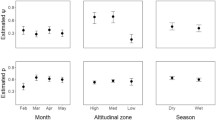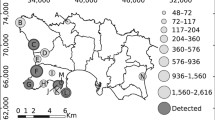Abstract
Occupancy-based monitoring programs rely on survey data to infer presence or absence of the target species. However, species may occupy a site and go undetected, leading to erroneous inference of absence (‘false absence’). If detectability is influenced by the time of year or weather conditions, survey protocols can be adjusted to minimize the chance of false absences. In this study, detection probabilities for three amphibian species from south-eastern Australia were modelled using a Bayesian approach. For aural surveys, we compared basic models, which only included effects of survey date, duration and time of day on detection, to models including additional effects of weather. Model selection using deviance information criterion (DIC) suggested that the basic model was the most parsimonious for Crinia signifera, while models including relative humidity and water temperature were most supported for Limnodynastes dumerilii and L. tasmaniensis respectively. When predictive performance was assessed by cross validation, DIC results were largely matched for C. signifera and L. dumerilii, while models of detection for L. tasmaniensis were indistinguishable, AUC scores suggesting inadequate performance. We show how results such as these can be used to design surveys, developing protocols for individual surveys and estimating the number of surveys required under those protocols to achieve a threshold cumulative probability of detection. Conservation managers can use these models to maximize the efficiency of surveys. This will improve the accuracy of occupancy data, and reduce the risk of misdirected conservation actions resulting from false absences.






Similar content being viewed by others
References
Araújo MB, Williams PH (2000) Selecting areas for species persistence using occurrence data. Biol Conserv 96(3):331–345
Barker J, Grigg GC, Tyler MJ (1995) A field guide to Australian Frogs. Surrey Beatty, Sydney
Bertoluci J, Rodrigues MT (2002) Seasonal patterns of breeding activity of Atlantic rainforest anurans at Boracia, southeastern Brazil. Amphibia-Reptilia 23(2):161–167
Bibby CJ, Buckland ST (1987) Bias of bird census results due to detectability varying with habitat. Acta Oecol, Oecol Gen 8(2):103–112
Boulinier T, Nichols JD, Sauer JR, Hines JE, Pollock KH (1998) Estimating species richness: the importance of heterogeneity in species detectability. Ecology 79(3):1018–1028
Bridges AS, Dorcas ME (2000) Temporal variation in anuran calling behavior: implications for surveys and monitoring programs. Copeia 2000:587–592
Brooks SP, Gelman A (1998) General methods for monitoring convergence of iterative simulations. J Comput Graph Stat 7:434–455
Burnham KP, Anderson DR (2002) Model selection and multimodal inference: a practical information-theoretic approach. Springer-Verlag, New York
Cook RP, Tupper TA, Paton PWC, Timm B (2011) Effects of temperature and temporal factors on anuran detection probabilities at Cape Cod national seashore, Massachusetts, USA: implications for long-term monitoring. Herpetol Conserv Biol 6(2):25–39
Daszak P, Cunningham AA, Hyatt AD (2000) Emerging infectious diseases of wildlife: threats to biodiversity and human health. Science 287(5452):443–449
de Solla SR, Shirose LJ, Fernie KJ, Barrett GC, Brousseau CS, Bishop CA (2005) Effect of sampling effort and species detectability on volunteer based anuran monitoring programs. Biol Conserv 121(4):585–594
Diefenbach DR, Brauning DW, Mattice JA (2003) Variability in grassland bird counts related to observer differences and species detection rates. Auk 120(4):1168–1179
Duellman WE, Trueb L (1986) Biology of amphibians. McGraw-Hill, New York
Evans JW, Evans CA, Packard JM, Calkins G, Elbroch M (2010) Determining observer reliability in counts of river otter tracks. J Wildlife Manag 73(3):426–432
Field SA, Tyre AJ, Possingham HP (2005) Optimizing allocation of monitoring effort under economic and observational constraints. J Wildlife Manag 69(2):473–482
Fleishman E, Mac Nally R, Fay JP, Murphy DD (2001) Modeling and predicting species occurrence using broad-scale environmental variables: an example with butterflies of the Great Basin. Conserv Biol 15(6):1674–1685
Gimenez O, Bonner SJ, King R, Parker RA, Brooks SP, Jamieson LE, Grosbois V, Morgan BJT, Thomas L (2009) WinBUGS for population ecologists: Bayesian modeling using Markov chain Monte Carlo methods. Environ Ecol Stat 3:883–915
Gu W, Swihart RK (2004) Absent or undetected? Effects of non-detection of species occurrence on wildlife-habitat models. Biol Conserv 116(2):195–203
Hanley JA, McNeil BJ (1982) The meaning and use of the area under a receiver operating characteristic (ROC) curve. Radiology 143:29–36
Heard GW, Robertson P, Scroggie MP (2006) Assessing detection probabilities for the endangered growling grass frog (Litoria raniformis) in southern Victoria. Wildlife Res 33(7):557–564
Heyer, W, Donnelly, M, McDiarmid, R, Hayek, L, Foster, M (eds) (1995) Measuring and monitoring biological diversity: standard methods for amphibians. Smithsonian Institution Press, Washington
Kéry M (2002) Inferring the absence of a species: a case study of snakes. J Wildlife Manag 66(2):330–338
Lotz A, Allen CR (2007) Observer bias in anuran call surveys. J Wildlife Manag 71:675–679
Lunn DJ, Thomas A, Best N, Spiegelhalter DJ (2000) WinBUGS: a Bayesian modelling framework: concepts, structure, and extensibility. Stat Comput 10:325–337
MacKenzie DI (2005) What are the issues with presence-absence data for wildlife managers?. J Wildlife Manag 69(3):849–860
MacKenzie DI, Royle JA (2005) Designing occupancy studies: general advice and allocating survey effort. J Appl Ecol 42(6):1105–1114
MacKenzie DI, Nichols JD, Lachman GB, Droege S, Royle AJ, Langtimm CA (2002) Estimating site occupancy when detection probabilities are less than one. Ecology 83(8):2248–2255
MacKenzie DI, Nichols JD, Hines JE, Knutson MG, Franklin AB (2003) Estimating site occupancy, colonization, and local extinction when a species is detected imperfectly. Ecology 84(8):2200–2207
Mazerolle MJ, Bailey LL, Kendall WL, Royle AJ, Converse SJ, Nichols JD (2007) Making great leaps forward: accounting for detectability in herpetological field studies. J Herpet 41(4):672–689
McCarthy MA (2007) Bayesian methods for Ecology. Cambridge University Press, Cambridge
Nichols JD, Boulinier T, Hines JE, Pollock KH, Sauer JR (1998) Estimating rates of local species extinction, colonization, and turnover in animal communities. Ecol Appl 8(4):1213–1225
Olson DM, Dinerstein E, Powell GVN, Wikramanayake ED (2002) Conservation biology for the biodiversity crisis. Conserv Biol 16(1):1–3
Pellet J, Schmidt BR (2005) Monitoring distributions using call surveys: estimating site occupancy, detection probabilities and inferring absence. Biol Conserv 123(1):27–35
Pierce BA, Gutzwiller KJ (2004) Auditory sampling of frogs: detection efficiency in relation to survey duration. J Herpet 38(4):495–500
Pierce BA, Gutzwiller KJ (2007) Interobserver variation in frog call surveys. J Herpetol 41(3):424–429
Pimm SL, Raven P (2000) Biodiversity: extinction by numbers. Nature 403:843–845
R Development Core Team (2008) R: a language and environment for statistical computing. R Foundation for Statistical Computing, Vienna, Austria, http://www.R-project.org, ISBN 3-900051-07-0
Schmidt BR (2005) Monitoring the distribution of pond-breeding amphibians when species are detected imperfectly. Aquatic Conserv: Marine Freshwater Ecosyst 15(6):681–692
Sing T, Sander O, Beerenwinkel N, Lengauer T (2005) ROCR: visualizing classifier performance in R. Bioinformatics 21(20):3940–3941
Spiegelhalter DJ, Best NG, Carlin BP, van der Linde A (2002) Bayesian measures of model complexity and fit (with discussion). J R Stat Soc, Ser B (Stat Methodol) 64(4):583–639
Steelman CK, Dorcas ME (2010) Anuran calling survey optimization: developing and testing predictive models of anuran calling activity. J Herpetol 44(1):61–68
Thomas CD, Cameron A, Green RE, Bakkenes M, Beaumont LJ, Collingham YC, Erasmus BFN, Ferreirade Siqueira M, Grainger A, Hannah L, Hughes L, Huntley B, van Jaarsveld AS, Midgley GF, Miles L, Ortega-Huerta MA, Townsend Peterson A, Phillips OL, Williams SE (2004) Extinction risk from climate change. Nature 427:145–148
Tracey JP, Fleming PJS, Melville GJ (2005) Does variable probability of detection compromise the use of indices in aerial surveys of medium-sized mammals?. Wildlife Res 32(3):245–252
Tyre AJ, Tenhumberg B, Field SA, Niejalke D, Parris KM, Possingham HP (2003) Improving precision and reducing bias in biological surveys: estimating false-negative rates. Ecol Appl 13(6):1790–1801
Watson CA, Weckerly FW, Hatfield JS, Farquhar CC, Williamson PS (2008) Presence-nonpresence surveys of golden-cheeked warblers: detection, occupancy and survey effort. Animal Conserv 11(6):484–492
Weir LA, Royle AJ, Nanjappa P, Jung RE (2005) Modeling anuran detection and site occupancy on North American Amphibian Monitoring Program (NAAMP) routes in Maryland. J Herpetol 39(4):627–639
Wintle BA, McCarthy MA, Parris KM, Burgman MA (2004) Precision and bias of methods for estimating point survey detection probabilities. Ecol Appl 14:703–712
Wintle BA, Kavanagh RP, McCarthy MA, Burgman MA (2005) Estimating and dealing with detectability in occupancy surveys for forest owls and arboreal marsupials. J Wildlife Manag 69(3):905–917
Acknowledgements
Data for the 2006–2007 season were collected in collaboration with Michael Scroggie and Brian Malone. The collection of these data was made possible by funding from the Department of Sustainability of Environment, the Growling Grass Frog Trust Fund (consisting of DSE, Australian Gas Ltd. and Friends of Merri Creek) and La Trobe University. It was undertaken according to the provisions of the Victorian Wildlife Act 1975 (Research Permit No. 10001816). Data for the 2009 season were collected in collaboration with Blaire Dobiecki and a number of field assistants. Data collection was made possible by funding from the University of Melbourne and was approved from the Animal Ethics Committee of the University of Melbourne (project ID 0911299.1). Manuscript preparation was supported by an Australian Research Council Linkage Grant (LP0990161) with the Australian Research Centre for Urban Ecology, Growling Grass Frog Trust Fund, Melbourne Museum, Melbourne Water, Parks Victoria and Victorian Department of Sustainability and Environment. Helpful comments were received from the editor and two anonymous referees.
Author information
Authors and Affiliations
Corresponding author
Rights and permissions
About this article
Cite this article
Canessa, S., Heard, G.W., Parris, K.M. et al. Integrating variability in detection probabilities when designing wildlife surveys: a case study of amphibians from south-eastern Australia. Biodivers Conserv 21, 729–744 (2012). https://doi.org/10.1007/s10531-011-0211-0
Received:
Accepted:
Published:
Issue Date:
DOI: https://doi.org/10.1007/s10531-011-0211-0




